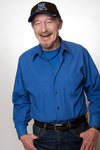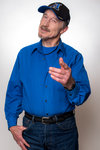

The life of a military football player in Japan during the Korean War had many benefits, among them the freedom to venture out into the city and take in the night life.
Warren Robertson, who had been mistaken as an All-American football player after being drafted into the military, and a group of fellow players were doing just that when his life took another fortuitous turn.
One can imagine a group of hulking human specimens gathered together at a watering hole with no shortage of conversation as they found themselves a world away from home.
Robertson must’ve stood out from his teammates, if only because he was smaller.
An American movie studio executive happened to be in the same establishment, and he was drawn like a magnet to the military men.
There was a movie to produce, and he was in search of military men to take a few small parts. Glorified extras, really.
“He wanted military men, but not someone taller than the actor,” Robertson recalled.
It’s a fact that likely made him a prime candidate for a small speaking role in what he imagined would be a second-tier production.
Robertson was already a big fan of film, so he understood the gaping distance between a blockbuster movie and a B-level flick.
As a child, Robertson had been afforded the opportunity to sweep up popcorn at the diminutive theatre of his dusty, off the beaten track hometown of Archer City, Texas.
There, between breaks from pushing popcorn and chasing away rats with a broom, he saw the early stars of the silver screen flashing in front of his eyes, providing a window to a world infinitely larger and more vibrant than his humble beginnings.
“It introduced me to Technicolor,” he said. “It taught me a person didn’t have to be the same all the time.”
Robertson certainly personified that reality.
Now, he was set to take part in it via a role in this film — he didn’t even know the title — that required the presence of a stand-in G.I.
Robertson found himself boarded in a fancy motel in a town hours away from his football barracks.
As it turned out, this wasn’t a “B movie.”
That realization struck as suddenly as he spotted the Marlon Brando shuffling about the hotel.
To this day, Brando is a man Robertson doesn’t tire of discussing. He admires the late actor’s presence on screen as a nuanced bad-boy of sorts, a turn from the early days of film when it was simple to see exactly who was good and who was bad.
Filmmakers made it obvious.
Brando, on the other hand, was subtle and calculated. “A sensitive brute,” as Robertson would say.
Brando had a way about him that made him perfect for the evolving world of Hollywood where actors were building new elements into their trade through the early introduction of method acting principals.
Now, assured that this was a cinematic creation of greater importance than he had assumed, Robertson was all the more excited to take part in it.
Anxious to absorb all he could from the experience, he woke up early, got dressed and made his way to the set, which was bisected by a rippling creek and illuminated by nearby street lights.
That's when he saw a familiar frame angling his way toward him in the earliest rays of the morning sun.
Closer and closer the man came, until his face was in focus.
“It was Marlon Brando!,” Robertson recalls with enthusiasm.
Battling the urge to be rendered starstruck, Robertson recalls a calm, relaxed conversation with the movie star, inquiring as much of Robertson as he of Brando.
He was particularly interested in Robertson’s newfound calling as a football player, a fact Robertson attributed to the actor’s tough-guy image, which seemed genuine but was not derived from masculine pursuits in athletics.
The film they both found themselves performing in, from vastly different circumstances, was “Sayonara,” the story of an American Air Force pilot who falls in love with a Japanese entertainer.
It would earn Brando an Academy Award nomination, and for Roberston a few on-screen lines and the rare opportunity to stand next to an icon.
It also put him firmly in Brando’s orbit.
The two eventually spent a night at a nearby geisha house where they chatted and socialized.
The famous actor and the kid from Archer City had hit it off.
It would be Robertson's first introduction, at least by way of a mention by Brando, of something called The Actor’s Studio and an “exciting new thing” called method acting.
After meeting a world-renowned actor in the process of acting like an All-American football player, Robertson eventually returned to the United States.
It had been 18 months and two tours since he was plucked out of the line of soldiers at Fort Lewis and thrust onto a new path.
That road had ended, though, as had the Korean War.
Robertson was immediately struck with something of an identity crisis.
He walked out of the gate at a New Jersey airport with limited money and non-existent plans for his future.
Robertson would no longer be “Robbie,” the name take came with the mistaken notion he was All-American George Robinson, but who would he become?
“That was one of the strangest moments of my life,” Robertson said. “I didn’t know who the hell I was … I didn’t have an occupation. I went to college, but I didn’t know what I wanted to do. I remember thinking, ‘Who am I?’
In the process of finding himself, he engaged in an extended stay with a friend in New York City. One night, while attending a party, he overheard a fellow attendee doing his best impression of Marlon Brando.
“Mine was better,” Robertson quipped.
Then, for a second time, someone mentioned The Actor’s Studio, a group of playwrights, actors and directors who worked their craft as a membership organization in the Hell’s Kitchen neighborhood of Manhattan.
Brando had discussed the studio with Robertson in Japan.
Lee Strasberg, an innovative and now famous acting coach, plied his trade there, Robertson was told.
What the heck, he thought.
“I picked up the phone book and, there he was, Lee Strasberg,” Robertson said.
Robertson would find work, and precious income, as a page at NBC headquarters in New York City.
He’d find his calling with Strasberg, who despite the odds, agreed to meet with Robertson after a simple phone call.
Robertson was too new to the scene to be shocked by the acting teacher’s willingness to meet with a man with virtually no experience.
“Naive would be derogatory,” he said. “Innocence is more correct. I didn’t know it was such an accomplishment to talk with Lee Strasberg … If I knew exactly what I was doing at the time, I wouldn’t have done it.”
On the day of the meeting, Robertson bumped into the actor Basil Rathbone in the elevator. The actor, made famous by his early portrayals of Sherlock Holmes, wasn’t as flashy and unapproachable as some perceive actors to be. If Rathbone was understated, then Strasberg was borderline boring, but intense.
“He was a little man, very contained. He’s not aloof. He’s just contained. And he perfected brevity,” Robertson said.
Strasberg started by asking questions following a list he went through with all the actors in his studio. He asked about Texas and Archer City, specifically centering on the rural upbringing he had no personal experience with.
“He was very fascinated by that,” Robertson said.
He was getting an early glimpse of Strasberg’s ability to really see inside of an individual.
“He did not waste words and he did not waste time,” he said. “He knew how to go inside the eyes … His real insight was the emotional side and being able to come up with creative exercises.”
The result was The Actor’s Studio, a place of glamor and mystery that had attracted the attention and attendance of the brightest stars from both Hollywood and Broadway.
“It was a little dangerous, but charged with talent,” Robertson said.
After the meeting, Robertson was added to that roster.
He recalls, about a week later, heading up the stairs to the studio, which after a fire was being housed in an old church.
As he walked in, he recognized faces from the silver screen, Paul Newman being among them.
“There sat some of the most famous movie stars of the era,” he said.
On one occasion, running about 20 minutes behind, Robertson shuffled into class to grab one of the last remaining seats. A half hour later, another tardy student walked in.
“The door opens and in walks Marilyn Monroe,” says Robertson.
Naturally, she found a seat near Robertson.
Robertson and the stars might not have shared much in common, but they were all largely equal in the eyes of Strasberg when it came to allocation of his time and attention.
They’d all be reduced to messy piles of emotion at times.
“Sooner or later, Lee finds the lock and opens the safe,” Robertson said. “Crying, screaming, rage, love and passion — all of it.”
To say it was a new scene for Robertson would be an understatement.
The studio dripped with fresh sensations and concepts.
“The people at the studio were doing things I had never seen in my hometown.” he said.
Specifically, they were showing emotions. All of them. They did so through the method acting tactics of Strasberg, who was increasingly bringing the art of acting ahead of even psychology at the time.
It manifested itself on the big screen through the performances of actors such as Brando and James Dean, who transformed the industry and gained hundreds of followers who craved the same learning platform, The Actors’ Studio.
In West Texas, men inherently guarded against any display of emotions. It was a fact so cemented in the culture and landscape that Robertson can still vividly remember the first time an adult relative shed tears.
A tornado had struck the town, and his hardened uncle wept and wailed as the house lifted, rattled and shook amid the storm.
“That changed my life,” Robertson said.
At the Actor’s Studio, it was anything but odd.
Strasberg’s methods, and those of Adler, who through a personal relationship also influenced Robertson, were geared toward bringing emotions from the depth of an actor’s psyche to the surface.
“That stunned me,” Robertson said. “In Archer City, whoever you were, that’s who you were. It didn’t change.”
The emotion-laden classes were laced with exercises that might seem mundane, but were in fact cutting edge. Students would spend hours watching a single person on stage, perhaps mimicking the movements necessary to hold and drink from an imaginary cup.
Beyond that, the scenes acted out in front of Robertson were in direct opposition to his conservative upbringing. For one, hearing a woman curse and swear was a new sensation. Then there was the absence of rigid politeness.
There was no need, Strasberg said, for Robertson to address his teacher as Mr. Strasberg.
Taken together, it shattered Robertson’s preconceived notions of the world.
“It was a whole new world for me,” he said. “It freed me up from my view of propriety … They knocked that out of me. They said, ‘You’re in New York now, and you need to get accustomed to saying words you’ve probably never heard before.’”
Three nights a week, Robertson devoted himself to the studio, never missing a class. He lacked pedigree, but not dedication.
That spilled over at home, where impromptu acting classes were beginning to form.
•••
Part Three of the three-part series focused on the life of Adna resident Warren Robertson, who achieved fame as an expert in method acting, will appear in Tuesday’s edition. See the previous installment online at www.chronline.com.